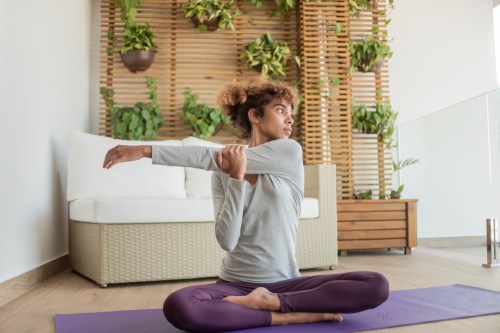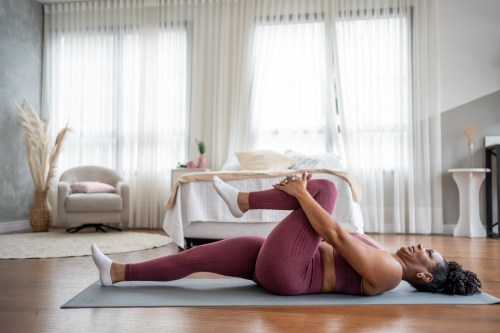The most common things we do each day that can throw our body alignment off
What to know about the everyday actions that are wrecking our body alignment and causing us to not move our best throughout the day.

You take time to stretch before and after each workout, and you see your doctor regularly for check-ups. You pay attention to your posture and try to incorporate yoga to build your abdominal and back strength. Generally speaking, you feel healthy and properly aligned, but still, sometimes you have unexplained aches-and-pains. What’s up with that?
If you ask Emily Kiberd, DC, founder of the Urban Wellness Clinic in New York City, the culprit could be seemingly innocent everyday activities that challenge your spine. According to her, the same way we develop positive habits, so too can our body also learns negative ones. “We are a blueprint of our actions, and most times what we do all day is not balanced,” she explains. “Imbalanced loading of certain muscles and joints can lead to repetitive strain and sprains. We become susceptible to new injuries, as well as increased likelihood of exacerbating existing issues.” So what could be to blame? These rituals that we’re all pretty much guilty of doing on the reg.
Sedentary behavior
You probably don’t need us to tell you that a sedentary lifestyle isn’t always great for your health. In addition to the stress it puts on your muscles, it can also compromise your ability to inhale and exhale effectively, especially if you are slouching over your computer. “If you’re sitting with poor posture, then it’s almost impossible to breathe deeply into your belly and use your diaphragm to its fullest potential. If we aren’t breathing properly then it creates a chain reaction of negative effects on our body,” she warns.
How to fix it: If you’re in a chair, Kiberd says to check yourself. Your feet should be grounded on the floor, spaced slightly wider than your hips. When you are seated upright, the angle between your legs and shoulders should be 90 degrees, and the chair should support all points of your back. “Try to find straight lines from your elbows forward to your wrists, with support from the armrests. Now, bring you keyboard and mouse close to you so you avoid reaching forward. Elbows should rest down by your ribs so there’s no pull on the upper traps,” she explains.
Then, glance at that inbox that’s overflowing on your laptop: Does your gaze hit the first third of the screen? If not, it could be too low, causing strain on your neck.
Bad seated posture
While Kiberd says it’s unpractical and impossible to sit in perfect form all-day, everyday, there are certain postures that are harder on our bodies than others. One that many love? Tucking their feet underneath their bottoms or sitting cross-legged. Though it tends to feels more comfortable for those who have developed the habit, sitting this way places increased tension on the delicate bundle of nerves behind the knee. This compresses the sciatic nerve and shortens the hamstrings until they feel tight. Eventually, it’s likely you’ll complain of lower-back pain if you sit this way too often, or for too long.
How to fix it: This one is a toughie to nix, and Kiberd says you’ll likely be more successful if you teach yourself to take breaks, rather than trying to go cold turkey. “Standing and moving not only helps your joint and muscles, it helps get your blood flowing which minimizes brain fog and boosts creativity,” she explains. When you do return to your desk, try sitting in proper form for at least thirty minutes before giving in to the temptation to cross your legs. When all else fails, though, try yoga:
Carrying a heavy bag on one shoulder
If your purse or gym bag could give Mary Poppins a run for her money, listen up: While many folks are attached to their everyday bags, it’s not a smart idea to consistently put more weight on one side of your body than the other. Kiberd explains this creates compensation patterns that will impact everything from your shoulders and neck to your knees, hips, and ankles. “Imbalance happens especially in rotation, and it’s hard to rotate your torso towards the shoulder your bag is sitting on. This throws everything off up and down the kinetic chain,” she adds.
How to fix it: Before you turn your nose up to the idea of a backpack and have flashbacks to elementary school, remember this accessory has become trendier as of late. From leather options to ones that take you from the office to barre class, there’s something for every budget and style. Kiberd says this allows weight to be more evenly distributed and is healthier for our upper body.
Wearing heels all day
Though sneaks for life is our motto at Well+Good, there are occasions for heels, but Kiberd says they can throw off your alignment. How so? Simply by wearing your favorite two-inch pair, you shift your center of gravity forward which shortens your calves, pushes your hips forward, and rounds your back. “This pushes all of our weight onto the front pad of your foot versus a stable base across the entire foot,” she continues. “The motor control center of the brain that stores our muscle memory adjusts accordingly, which affects our balance, gait, and puts unusual strain on joints.”
How to fix it: If you can’t get away with flats — or you simply love your block heels! — Kiberd urges fashionistas to wear ‘em sparingly. And at the very least, ensure you commute in something comfortable, so you’re not putting too much angst on your body. For those days when you spend hours on your toes, she suggests doing stretches for your calves and feet at night for a little extra TLC.
Looking down at our phones all day
Raise your hand if you’re doing this right now? Kiberd says in addition to the obvious neck and upper back pain, this forward position of the neck draws our shoulders forward, shortening the muscles in the front of our chest. Each and every time you do this, you’re teaching your body to complete a cycle Kiberd labels ‘vicious’ of rounding your upper body. This makes it increasingly more difficult to hold a proper posture as Instagram, Facebook, and your email demand your attention.
How to fix it: When you’re checking your phone, pull it up to eye level, as you would when taking a photo. Or if you can pull it off, only glance at your screen with your eyes, and not your whole head. But if you want to be kind to your body, as well as your mind, limit screen time. After all, there are plenty of posture-positive stretches you can do instead of seeing how many double-taps your latest post attracted. Your bod—and chiropractor—will thank you.
Oh hi! You look like someone who loves free workouts, discounts for cult-fave wellness brands, and exclusive Well+Good content. Sign up for Well+, our online community of wellness insiders, and unlock your rewards instantly.
Sign Up for Our Daily Newsletter
Get all the latest in wellness, trends, food, fitness, beauty, and more delivered right to your inbox.
Got it, you've been added to our email list.










